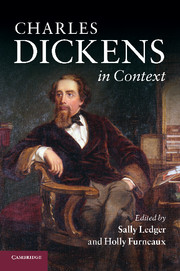Book contents
- Frontmatter
- Contents
- List of illustrations
- Notes on contributors
- Preface
- Notes on references
- PART I LIFE AND AFTERLIFE
- PART II SOCIAL AND CULTURAL CONTEXTS
- 12 Popular culture
- 13 The rise of celebrity culture
- 14 The newspaper and periodical market
- 15 Authorship and the professional writer
- 16 The theatre
- 17 Melodrama
- 18 The Bildungsroman
- 19 Visual culture
- 20 The historical novel
- 21 The illustrated novel
- 22 Christmas
- 23 Childhood
- 24 Work
- 25 Europe
- 26 The Victorians and America
- 27 Educating the Victorians
- 28 London
- 29 Politics
- 30 Political economy
- 31 The aristocracy
- 32 The middle classes
- 33 Urban migration and mobility
- 34 Financial markets and the banking system
- 35 Empires and colonies
- 36 Race
- 37 Crime
- 38 The law
- 39 Religion
- 40 Science
- 41 Transport
- 42 Illness, disease and social hygiene
- 43 Domesticity
- 44 Sexuality
- 45 Gender identities
- Further reading
- Index
13 - The rise of celebrity culture
Published online by Cambridge University Press: 05 August 2012
- Frontmatter
- Contents
- List of illustrations
- Notes on contributors
- Preface
- Notes on references
- PART I LIFE AND AFTERLIFE
- PART II SOCIAL AND CULTURAL CONTEXTS
- 12 Popular culture
- 13 The rise of celebrity culture
- 14 The newspaper and periodical market
- 15 Authorship and the professional writer
- 16 The theatre
- 17 Melodrama
- 18 The Bildungsroman
- 19 Visual culture
- 20 The historical novel
- 21 The illustrated novel
- 22 Christmas
- 23 Childhood
- 24 Work
- 25 Europe
- 26 The Victorians and America
- 27 Educating the Victorians
- 28 London
- 29 Politics
- 30 Political economy
- 31 The aristocracy
- 32 The middle classes
- 33 Urban migration and mobility
- 34 Financial markets and the banking system
- 35 Empires and colonies
- 36 Race
- 37 Crime
- 38 The law
- 39 Religion
- 40 Science
- 41 Transport
- 42 Illness, disease and social hygiene
- 43 Domesticity
- 44 Sexuality
- 45 Gender identities
- Further reading
- Index
Summary
The terms of this title are important: not ‘birth’ but ‘rise’, and – especially – not ‘fame’ but ‘celebrity’. For the large majority of cultural critics, ‘celebrity’ is an exclusively, almost relentlessly twentieth-century phenomenon, which had its ‘birth’ at the junction of late capitalist commodity culture and the explosion of mass media; it is a formation of modernity and a symptom of its ills. If the phenomenon is dated, it is, at the earliest, to the last decades of the nineteenth century (the launching of Tid-Bits, in 1884), or, much more often, to the 1910s (the signing of the first million-dollar movie contract by Mary Pickford, in 1916). If literary figures are discussed, they are Scott Fitzgerald and Ernest Hemingway – writers who were also (to some degree) performers – with occasionally a nod to Oscar Wilde. And because students of literature have inherited the wall erected by Victorian men of letters between ‘serious’ and merely ‘popular’ writing, we have also, by and large, willingly accepted this analysis and these divisions.
So, do we risk anachronism in considering the rise of celebrity culture in the Victorian period? It will be the argument of this chapter that we emphatically do not: the very word ‘celebrity’, in its current meaning (a celebrated person; a public character; someone who is much talked about) dates from the later 1840s. The categories of analysis and the structural breakdown of modern celebrity offered by cultural critics prove genuinely revealing for nineteenth-century culture.
- Type
- Chapter
- Information
- Charles Dickens in Context , pp. 98 - 108Publisher: Cambridge University PressPrint publication year: 2011
- 6
- Cited by

